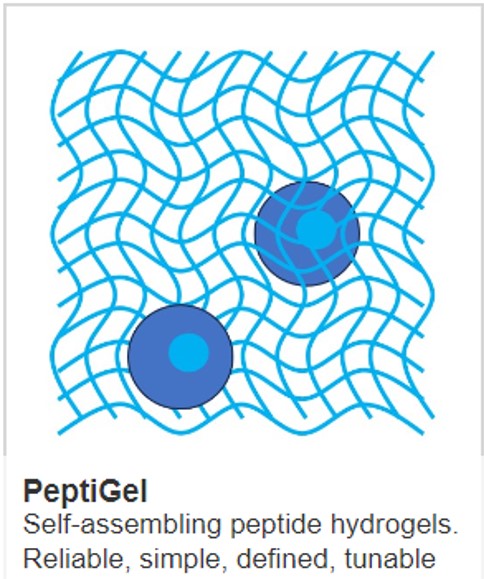PeptiGel vs Collagen

When discussing 3D Cell Culture, researchers and scientists talk about collagen, as it is quite popular as a matrix material. Collagen does have limitations as a scaffold though, in a similar way to many other natural scaffold materials, which is one of the reasons why Cell Guidance Systems are offering a fully synthetic alternative – PeptiGels.
In this article, we will discuss Collagen and PeptiGels®, and the benefits you can expect to derive from each when using them as a scaffold material.
Introduction to Collagen
Type 1 collagen is one of the main structural components of the extracellular matrix (ECM) and connective tissue. It is found in over 30% of total body protein, which makes it an excellent biomaterial for 3D printing applications and tissue engineering.
Collagen works by forming fibrous networks in the body, to enhance the structural integrity of the ECM while also promoting biological signalling, cell adhesion, growth and tissue morphogenesis. It offers a favourable environment for cell growth as it mimics the natural ECM of the tissues, exhibits biocompatible and biodegradation properties, and is self-assembling.
However, the main problem with using collagen for 3D printing and bioprinting is that it has low mechanical properties which can lead to difficulties in printing, less rigid tissue structures and decreased support for cells in the tissue.
Introduction to PeptiGels®
PeptiGels® are fully synthetic and therefore a great alternative to naturally-derived collagen. The platform technology that we use, allows us to control and drive the self-assembly of fully synthetic oligo-peptides into 3D fibrillar hydrogels – that mimic the ECM.
Peptides are the building blocks of nature, and so our ECM scaffolds are inherently biocompatible, as well as providing the most suitable environment for cells to not only survive but thrive.
PeeptiGels® were developed to enable life science researchers to achieve in vitro models that are more representative of the in vivo environment, and that are:
- Animal-Free – for more ethical research
- Biocompatible – helping you to translate your research to the clinic setting
- Ready-to-use – no extra preparation steps are required when supplied
- Reproducible – no variation in product quality means achieving the same results time after time
PeptiGels® are rapidly gaining in popularity thanks to the fact we can tailor them to your exact needs – including functionality and mechanical stiffness, meaning we can also include relevant cell recognition sequences that may be present in the native ECM.
Property Comparison of PeptiGels® and Collagen:
As you can see from the table below, both PeptiGels® and collagen offer an environment that is suitable for growing cells, but we believe that PeptiGels® have the edge when it comes to the use of innovative materials and methods, helping to support the generation of new platforms that are suitable to sustain both 3D cell growth and tissue formation in vitro.
IMAGE PeptiGel CREDIT Cell Guidance Systems



